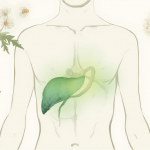St. John’s Wort: Nature’s Mood Booster with Ancient Roots

St. John’s Wort (Hypericum perforatum) is a bright yellow flowering plant that has been valued for centuries. Traditionally used in folk medicine, it remains one of the most popular herbal remedies for mood support today.
Because this herb offers many benefits yet also comes with important cautions, it is essential to understand both sides. In this guide, you’ll learn what St. John’s Wort looks like, where it grows, its health benefits, and how to use it safely.
What St. John’s Wort Looks Like
To begin with, spotting St. John’s Wort is straightforward. The plant has sunny, yellow flowers that stand out in meadows and along roadsides. Each flower has five petals covered in tiny black dots, which contain its active compounds.
In terms of size, it grows between 1 and 3 feet tall with slender green leaves. Interestingly, when you hold the leaves up to the light, you can see small translucent holes. As a result, this “perforated” look explains its Latin name perforatum.
Where You Can Find St.John’s Wort
Originally native to Europe, St. John’s Wort has spread widely. Today it grows in North America, parts of Asia, and many other regions.
Moreover, St. John’s Wort thrives in sunny, open spaces such as fields, roadsides, and disturbed soil where other plants may struggle. In addition, it typically blooms between June and September, depending on the local climate. On the other hand, it does not thrive in shady, damp environments.
Health Benefits and Uses – St. John’s Wort
Mood Support
First and foremost, St. John’s Wort is best known for mood support. A large number of studies suggest it may help with mild to moderate depression and even reduce anxiety in some cases.
Unlike prescription antidepressants, the herb works on several brain chemicals at once, including serotonin, dopamine, and norepinephrine. Consequently, many people find it effective for emotional balance.
Additionally, pairing herbal remedies with lifestyle practices like meditation for inner peace can further improve results.
St John’s Wort – Natural Anti-Inflammatory
Traditionally, St. John’s Wort was also used for healing wounds and reducing swelling. Thanks to compounds with anti-inflammatory properties, it may help treat minor skin injuries, burns, and bruises.
In fact, topical oils and creams made from the plant are still popular today. People also apply them for muscle aches and joint pain, which makes it a versatile remedy. For instance, many people use infused oils on small cuts or sunburns.
Nerve Pain Relief
Another area where St. John’s Wortshows promise is nerve pain, including sciatica and neuralgia. The compounds in the plant appear to calm overactive nerves and reduce pain signals.
Nevertheless, research is still ongoing. Therefore, it should be used with caution until more is understood.
St. John’s Wort May help Menopause Symptoms
Furthermore, some women find St. John’s Wort helpful for menopause symptoms such as mood swings and irritability. In addition, certain studies also suggest it may ease hot flashes.
Even so, it often works best when combined with other herbs for menopause relief, alongside diet and exercise adjustments. In conclusion, combining approaches increases effectiveness.
How to Use St. John’s Wort
There are four main forms of this herb, each with its own advantages:
- Capsules and tablets – The most common form, typically standardized to contain 0.3% hypericin. A typical dosage is 300 mg three times daily.
- Tinctures – Liquid extracts that act more quickly and can be mixed with water.
- Teas – Gentle and mild, tea is suitable for light mood support but less potent.
- Topical oils and creams – Applied directly to the skin for wounds, bruises, and muscle pain.
Because product quality can vary, it is important to choose supplements from reputable brands that use third-party testing.
Important Safety Warnings
Drug Interactions
Above all, the biggest risk of St. John’s Wort lies in drug interactions. It can cause the liver to metabolize certain medications too quickly, making them less effective.
Common interactions include:
- Antidepressants (risk of dangerous reactions)
- Birth control pills (reduced effectiveness)
- Blood thinners like warfarin
- Heart medications
- Anti-seizure drugs
- Some cancer treatments
For example, the NCCIH review on St. John’s Wort highlights several of these risks.
Other Precautions
- Sun sensitivity: This herb can make skin more sensitive to sunlight, leading to quicker burns.
- Pregnancy and breastfeeding: Not enough research exists to confirm safety, so avoid use during these times.
- Depression severity: St. John’s Wort is only useful for mild to moderate cases. Severe depression always requires medical care.
Most importantly, never stop prescription medications or replace them with St. John’s Wort without consulting a healthcare provider. As a result, professional guidance is essential for safe use.
The Bottom Line
To sum up, St. John’s Wort offers real benefits but also serious risks. When used properly, it may support mood, reduce inflammation, and even ease menopause or nerve pain.
However, safe use requires awareness of interactions and guidance from a healthcare professional. Therefore, with the right approach, this ancient herb can be a valuable part of your natural health toolkit.
Learn More
For more on this herb, watch Rosalee de la Forêt’s excellent breakdown: Herbs with Rosalee on YouTube. She offers clear, evidence-based insights into St. John’s Wort and other healing plants.
Herbs with Rosalee has a great talk about St John’s Wort on YOUTUBE

